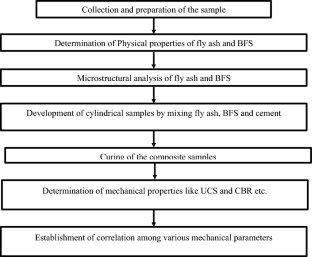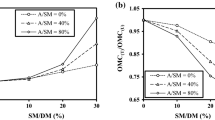Abstract
The paper deals with developing fly ash–Blast Furnace Slag (BFS) composite with additives like cement to utilize waste material in engineering applications. The additive-like cement with different proportions has gained particular attention worldwide because of the excellent bonding strength and enhancement of mechanical properties of fly ash composite with other admixtures. The geomechanical properties such as Unconfined Compressive Strength (UCS), Brazilian Tensile Strength (BTS), and California Bearing Ratio (CBR) of the developed composite at different curing periods (0, 7, 14, and 28 days) are reported in these studies. The optimum strength of the composite was determined at the maximum utilization of fly ash and BFS composite. The correlation among different strength parameters was established using the statistical approach. The composite with 80% fly ash, 12% BFS, and 8% cement showed the highest compressive strength. The results indicated an excellent bonding between the constituent materials of the composite with an adequate amount of strength. The strength parameters indicated the utilization of composite in haul road construction as a base or sub-base layer. Using composite will help the stable haul road and consume the bulk of fly ash and BFS to reduce environmental pollution.




















Similar content being viewed by others
Data availability
The data used in the research work has been presented in the manuscript.
References
Lokeshappa, B., & Dikshit, A. K. (2011). Single step extractions of metals in coal fly ash. Materials and Structures, 2, 01–08.
International Energy Agency. (2016). Energy and air pollution. World energy outlook special report.
Yuan, C. C., Fang, W. C., Mui, D. T., & Chiang, H. L. (2009). Application of methods (sequential extraction procedures and high-pressure digestion method) to fly ash particles to determine the elements a case study of BCR 176. Journal of Hazardous Materials, 163, 578–587.
Gorhan, G., & Kurklu, G. (2014). The influence of the NaOH solution on the properties of the fly ash-based geopolymer mortar cured at different temperatures. Composites, Part B: Engineering, 58, 371–377.
Kavitha, O. R., & Nandhinipriyaa, K. C. (2017). Effect of bottom ash as a mineral admixture in concrete. Journal of King Saud University Engineering Sciences, 10, 134–139.
Karthik, A., Sudalaimani, K., Vijayakumar, C.T. (2017). Durability study on coal fly ash-blast furnace slag geopolymer concretes with bio-additives. Ceramics International, 43, 11935–11943.
Leemann, A., Shi, Z., & Lindgard, J. (2020). Characterization of amorphous and crystalline ASR products formed in concrete aggregates. Cement and Concrete Research, 131, 105913.
Adriano, D. C., Page, A. L., Elseewi, A. A., Chang, A. C., & Straughan, I. (1980). Utilization and disposal of fly ash and other coal residues in terrestrial ecosystems: a review 1. Journal of Environmental Quality, 9, 333–344.
Aitken, R. L., & Bell, L. C. (1985). Plant uptake and phytotoxicity of boron in Australian fly ashes. Plant and Soil, 84, 245–257.
Mattigod, S. V., Rai, D., Eary, L. E., & Ainsworth, C. C. (1990). Geochemical factors controlling the mobilization of inorganic constituents from fossil fuel combustion residues: I. Review of the major elements. Journal of environmental quality, 19, 188–201.
Jain, V., Umesh, B. R., Venugopal, V. W., & Pradip, T. (2013). Processing of alumina-rich iron ore slimes: Is the selective dispersion–flocculation–flotation the solution we are looking for the challenging problem facing the Indian iron and steel industry. Transactions of the Indian Institute of Metals, 66, 447–456.
Giergiczny, Z. (2020). Fly ash and slag. Cement and Concrete Research, 124, 105826.
Ghanim, A. A. J., Amin, M., Zeyad, A. M., Tayeh, B. A., & Agwa, I. S. (2023). Effect of modified nano-titanium and fly ash on ultra-high-performance concrete properties. Structural Concrete, 1, 1464–4177.
Hakeem, I. Y., Abd-Al Ftah, R. O., Tayeh, B. A., & Hafez, R. D. A. (2023). Eggshell as a fine aggregate replacer with silica fume and fly ash addition in concrete: A sustainable approach. Case Studies in Construction Materials, 18, e01842.
Qaidi, S. M. A., Tayeh, B. A., Isleem, H. F., de Azevedo, A. R. G., Ahmed, H. U., & Emad, W. (2022). Sustainable utilization of red mud waste (bauxite residue) and slag for the production of geopolymer composites: A review. Case Studies in Construction Materials, 16, e00994.
Elsayed, M., Tayeh, B. A., Aisheh, Y. I. A., El-Nasser, N. A., & Elmaaty, M. A. (2022). Shear strength of eco-friendly self-compacting concrete beams containing ground granulated blast furnace slag and fly ash as cement replacement. Case Studies in Construction Materials, 17, e01354.
Alaloul, W. S., Musarat, M. A., Haruna, S., Law, K., Tayeh, B. A., Rafiq, W., & Saba Ayub, S. (2021). Mechanical properties of silica fume modified high-volume fly ash rubberized self-compacting concrete. Sustainability, 13, 5571.
Alahrache, S., Winnefeld, F., Champenois, J. B., Hesselbarth, F., & Lothenbach, B. (2016). Chemical activation of hybrid binders based on siliceous fly ash and Portland cement. Cement and Concrete Composites, 66, 10–23.
Li, C., Hao, Y. F., & Zhao, F. Q. (2018). Preparation of fly ash-granulated blast furnace slag-carbide slag binder and application in total tailings paste backfill. IOP Conference Series, Materials Science and Engineering, 322, 4–8.
Pimraksa, K., Chindaprasirt, P., Sanjayan, J., & Ling, T. C. (2018). Alternative cementitious materials and their composites. Advances in Materials Science and Engineering, 2018, 1–2.
Barnard, R. (2014). Mechanical properties of fly ash/slag based geopolymer concrete with the addition of macro fibres. Dissertation, Stellenbosch University.
Yazici, H., Aydin, S., Yigiter, H., & Baradan, B. (2005). Effect of steam curing on class C high-volume fly ash concrete mixtures. Cement and Concrete Research, 35, 1122–1127.
Rupnow, T. D., Wang, K., Schaefer, V., & Tikalsky, P. (2010). A simple method for characterizing and predicting temperature behavior of ternary cementitious systems. Journal of Construction and Building Materials, 25, 2290–2297.
Alghazali, H., Aljazaeri, R., & Myers, J. J. (2020). Effect of accelerated curing regimes on high volume fly ash mixtures in precast manufacturing plants. Cement and Concrete Research, 137, 106190.
Behera, B., & Mishra, M. K. (2012). Strength assessment and compositional analysis of lime stabilized fly ash and mine overburden mixes upon curing. The Journal of Solid Waste Technology and Management, 38, 211–221.
Mallick, S. R., Mishra, M.K. (2013). Geotechnical characterization of clinker-stabilized fly Ash - coal mine overburden mixes for subbase of mine haul road. Coal Combustion and Gasification Products, 5, 51–56.
Alvin, H., Srivastava, V., & Herbent, A. (2014). Effect of fly-ash on compressive strength of Portland Pozzolona cement concrete. Journal of Academia and Industrial Research, 2, 2278–5213.
Kalla, P., Misra, A., Gupta, R. C., Csetenyi, L., Gahlot, V., & Arora, A. (2013). Mechanical and durability studies on concrete containing wollastonite–fly ash combination. Construction and Building Materials, 40, 1142–1150.
ASTM, UTS-0602 (2020) Soil Compaction Testing Equipment, ASTM International 100 Barr Harbor Drive, PO Box C700, West Conshohocken, PA 19428-2959. United States.
IS 2720-Part 10 (1991) Methods of test for soils part 10: Determination of unconfined compressive strength, Second Revision, Bureau of Indian standards, Manak Bhavan, 9 Bahadur Shah Zafar Marg, New Delhi India.
IS 2720-Part 16 (1987) Methods of test for soil part 16: Laboratory determination of CBR, Manak Bhavan, 9 Bahadur Shah Zafar Marg, New Delhi India.
IS 2720-Part 4 (1985) Methods of test for soils part 4: Grain size analysis, Bureau of Indian standards, Manak Bhavan, 9 Bahadur Shah Zafar Marg, New Delhi India.
IS 2720-Part 3 (1980) Methods of test for soils part 3: Determination of specific gravity, Bureau of Indian standards, Manak Bhavan, 9 Bahadur Shah Zafar Marg, New Delhi India.
Behera, B. (2012). Experimental and numerical investigation into behaviour of fly ash composite material in the subbase of surface coal mine haul road. PhD thesis, NIT Rourkela.
IS 1760-Part 1 (1991) Methods of chemical analysis of limestone, dolomite and allied materials, Part 1: Determination of loss on ignition, Manak Bhavan, 9 Bahadur Shah Zafar Marg, New Delhi India.
IS 2720-Part 5 (1985) Method of test for soils part 5: Determination of liquid and plastic limit, Manak Bhavan, 9 Bahadur Shah Zafar Marg, New Delhi India.
IS 2720-Part 6 (1972) Methods of test for soils part 6: Determination of shrinkage factors, Manak Bhavan, 9 Bahadur Shah Zafar Marg, New Delhi India.
Chethan, B. A., & Shankar, A. U. R. (2023). Effect of flash flood and weather changes on unconfined compressive strength of cement- and fly ash-stabilized black cotton soil used as road materials. International Journal of Pavement Research and Technology, 16, 195–211.
ASTM D3967 – 23 (2023) Standard Test Method for Splitting Tensile Strength of Intact Rock Core Specimens with Flat Loading Platens, ASTM International, 100 Barr Harbor Drive, PO Box C700, West Conshohocken, PA 19428-2959. United States.
Marathe, S., Mithanthaya, I. R., Mithun, B. M., Shetty, S., & Akarsh, P. K. (2020). Performance of slag-fly ash based alkali activated concrete for paver applications utilizing powdered waste glass as a binding ingredient. International Journal of Pavement Research and Technology, 14, 196–203.
Mehta, P. K., & Monteiro, P. J. (2017). Concrete microstructure, properties and materials (4th ed., Vol. 1, p. 142). McGraw Hill Education.
Yildirim, I. Z., & Prezzi, M. (2011). Chemical, mineralogical, and morphological properties of steel slag. Advances in Civil Engineering, 2011, 254–260.
Tikalsky, P. J., Roy, D., Scheetz, B., & Krize, T. (2002). Redefining cement characteristics for sulfate-resistant Portland cement. Cement and concrete research, 32, 1239–1246.
C618 – 08a (2008) Standard Specification for Coal Fly Ash and Raw or Calcined Natural Pozzolan for Use in Concrete, ASTM International, 100 Barr Harbor Drive, PO Box C700, West Conshohocken, PA 19428-2959. United States.
Zhou, J., Qian, S., Beltran, M. G. S., Ye, G., Breugel, K. V., & Li, V. C. (2010). Development of engineered cementitious composites with limestone powder and blast furnace slag. Materials and Structures, 43, 803–814.
Shi, Z., & Lothenbach, B. (2019). The role of calcium on the formation of alkali–silica reaction products. Cement and Concrete Research, 126, 105898.
Garga, M., & Pundi, A. (2015). Development of fly ash-based composite binder and its application in construction materials. European Journal of Environmental and Civil Engineering, 19, 1253–1267.
Morsy, M. S., Alsayed, S. H., & Salloum, Y. A. (2012). Development of eco-friendly binder using metakaolin–fly ash–lime-anhydrous gypsum. Construction and Building Materials, 35, 772–777.
Bowles, J. (1992). Engineering properties of soil and their measurements (4th ed.). McGraw-Hill.
Ismaiel, H. A. H. (2006). Treatment and improvement of the geotechnical properties of different soft fine-grained soils using chemical stabilization. Ph.D. thesis, Martin Luther University Halle Wittenberg, Minnesota.
MnDOT. (2018). Schedule of materials control. Standard Specifications, 1, 1–76.
AASHTO: T 193-99 (2003) Standard Method of Test for The California Bearing Ratio, American Association of State and Highway Transportation Officials.
Funding
No funding was obtained for this study.
Author information
Authors and Affiliations
Contributions
All authors of this research paper have directly participated in the planning, execution, or analysis of this study.
Corresponding author
Ethics declarations
Conflict of Interest
On behalf of all authors, the corresponding author states that there is no conflict of interest.
Rights and permissions
Springer Nature or its licensor (e.g. a society or other partner) holds exclusive rights to this article under a publishing agreement with the author(s) or other rightsholder(s); author self-archiving of the accepted manuscript version of this article is solely governed by the terms of such publishing agreement and applicable law.
About this article
Cite this article
Kumar, H., Munisingh, M.S. Development and Characterization of Fly Ash–BFS–Cement Composite for Engineering Applications. Int. J. Pavement Res. Technol. (2024). https://doi.org/10.1007/s42947-024-00439-7
Received:
Revised:
Accepted:
Published:
DOI: https://doi.org/10.1007/s42947-024-00439-7




